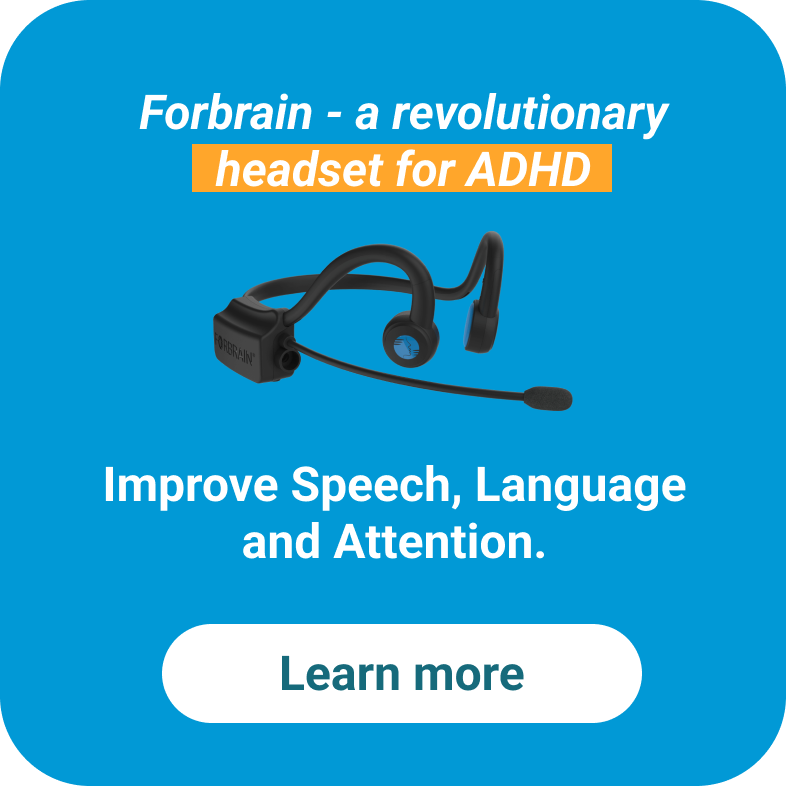Best Practices for Classroom ADHD Accommodations
 Amy Yacoub
Amy Yacoub Speech-Language Pathologist
September 11, 2023

Classroom Accommodations for ADHD | Individualized Education Plans for ADHD | 504 Plan for ADHD | Using Forbrain
Attention Deficit Hyperactivity Disorder (ADHD) causes individuals to face unique challenges within a classroom setting, including difficulty focusing, interacting with peers, and managing tasks. Providing the necessary support for an individual with ADHD can give the student the best chances of succeeding academically.
Here we’ll dive into the recommended best practices for classroom ADHD accommodations, including tools for task management, time management, and social accommodations.
Classroom Accommodations for ADHD
Classroom accommodations play a critical role in mitigating the challenges that students with ADHD face in successful participation in a classroom setting.
According to research, accommodations are the most common response to ADHD in educational settings. This is because of the demands in the classroom setting for sustained attentional focus and self-control, which are typically difficult for students with ADHD.
This comprehensive list of classroom accommodations can be used as a guide to address the unique needs of students with ADHD.
Task Management Accommodations
Individuals with ADHD typically have difficulty with various areas of a set of cognitive skills known as executive functioning. This includes difficulty planning, organizing, prioritizing, and focusing on tasks.
ADHD accommodations can provide students with extra support for effectively using these necessary cognitive processes for completing academic tasks. These include:
Make Assignments Clear and Manageable
Academic tasks can be manipulated to meet the needs of the student by reducing the length of the task itself and dividing tasks into sub-units. Students with ADHD often have difficulty with planning, organizing, and executing tasks efficiently, in addition to trouble focusing. Breaking down large tasks into ones that are shorter and more manageable can make it easier for individuals with ADHD to complete.
Give Explicit Instructions
Instructions for academic tasks should be clear and concise to ensure that students with ADHD are better able to process and retain them. Individuals with ADHD often have working memory difficulties, so longer or more ambiguous instructions can be hard for them to follow.
Strategy Training
Research shows that teaching a child with ADHD a specific skill that they can implement within an academic situation can improve their performance.
For example, strategies for completing a certain skill like a basic number processing task can be taught for the child to utilize in the classroom.
Self Monitoring
Students can set individual goals for accurately completing academic tasks, monitor their own performance, and receive positive rewards for their successes.
This self-monitoring can help students with ADHD stay focused, track their own progress, and actively participate in their learning. Knowing and utilizing strategies empowers the student to apply helpful strategies to improve their performance and remain focused while completing tasks.
Environmental Accommodations
Creating an academic learning environment that accounts for the unique needs of a student with ADHD is crucial to facilitating their success. Here are some ways that a classroom setting can be uniquely designed to account for the needs of an individual with ADHD:
Provide Flexible Seating
Allow the student to have access to alternative seating options that account for their sensory needs. For example, sitting on a stability ball or using a standing desk can provide a student with the sensory input they seek so that they can concentrate better on academic tasks.
Incorporating movement breaks into tasks in which students are seated allows them to release energy to improve their focus.
Minimize Distractions
Seat the student near the front of the class, closer to the teacher, to minimize distractions so he or she can focus more easily.
Reduce visual distractions at the child’s desk. If seated in a small group, consider reducing the number of students seated around the child with ADHD.
Pomodoro Method
The student works with strict concentration in a 25 minute sprint (“pomodoro”), with a 5 minute break in between sprints. These breaks allow individuals with ADHD to re-energize and refuel their brains so they can strongly refocus on the task.
Set a timer to help the student effectively manage time. This promotes focus and productivity by providing the student with a visual and auditory reminder of how much time they have left.
Time Management Accommodations
Due to difficulties with executive functioning tasks and distractibility, time management can be particularly difficult for individuals with ADHD within a classroom setting. Tools such as visual aids, notebooks, and allowing extra time can set the student up for success.
Give Notebooks and Visual Tools
Using notebooks, calendars, and visual schedules should be used to combat the working memory and short term memory challenges of many students with ADHD.
Provide visual aids to represent timelines and deadlines for academic tasks.
Provide a Lesson Outline Beforehand
Give the student an outline of the day’s lesson ahead of time so he or she can prepare for the tasks.
Allow the student to preview and organize the materials they’ll need in advance.
Allow Flexibility in Testing/Tasks
To account for differences in verbal and nonverbal language skills, permit students to use alternative methods of demonstrating understanding of academic information (i.e., oral presentations versus written responses). Provide options for completing assignments at different times, which may be easier for the student to focus.
Give Extra Time and Quite Place
Extend the amount of time allowed for completing tests and assignments to account for difficulties or delays in processing and memory skills often shown by individuals with ADHD.
Provide a quiet environment for the student to work. This can improve the individual’s ability to focus on the task at hand by eliminating distracting sounds.
Structured Schedule
Establishing and maintaining a consistent daily schedule gives students with ADHD a sense of predictability that can help them stay on task. By clearly outlining daily routines and transitions, the child can more easily stay focused because he or she knows what to expect.
Use of Sensory Tools
Certain tools can provide students with ADHD with the sensory stimulation they seek, which can help them channel excess energy and improve their focus during academic tasks.
Fidget Toys
Stress balls, sensory putty, and other fidget tools can be used in the classroom discreetly by the child.
Students should be empowered to use self-monitoring techniques to identify moments they are having trouble focusing and use fidget tools to help.
Wiggle Seats
Sitting on a uniquely textured cushion such as a wiggle seat can provide students with sensory stimulation so they can remain seated during tasks for longer.
Hands-on Tasks
Modifying tasks so they are more hands-on can increase the student’s focus.
Drawing letters in shaving cream or sand, for example, provides a student with tactile input that can help them concentrate on tasks more efficiently.
Use of Technology
Assistive technology and specific devices can aid in focus and organization for students with ADHD.
Educational Apps or Software
Students can use apps and software specifically designed for children with ADHD. These can help children study educational material, and manage ADHD symptoms by helping them stay organized and manage parts of their school day.
Timers
Visual/digital timers like the Brain Focus Productivity Timer can encourage productivity by breaking work into focused intervals, interspersed with short breaks.
Streaming Music
Listening to music has been shown by research to enhance concentration and performance in individuals with ADHD. Students can stream calming music to help them focus on tasks.
Forbrain
Forbrain is an auditory stimulation headset that can be used as a unique accommodation for students with ADHD. By using bone conduction technology, Forbrain is designed to enhance an individual’s ability to process auditory information and integrate sensory input. This can result in improvements in attention, focus, and communication skills for individuals with ADHD.
Forbrain can be incorporated into the toolkit of accommodations to support students with ADHD within academic settings.
Social and Emotional Support
ADHD can often lead to frustration, anxiety, or difficulties in forming and maintaining relationships, so providing social and emotional support is critical for students’ overall well-being and success.
Peer Support and Collaboration
Pair the student with a reliable peer who can assist with tasks like note-taking, organizing materials, and providing reminders. Peer mentors can help the student remain on task and offer emotional support.
Social Skills Training
Incorporate social skills training into the classroom or as part of individual education plans (IEPs). Students with ADHD can benefit from lessons on emotional regulation, interpersonal communication, and conflict resolution.
Counselor or Support Group
Offer access to a school counselor or a support group where students with ADHD can share experiences, receive guidance, and develop coping strategies in a safe and understanding environment.
Final Words
Individuals with ADHD face specific challenges in academic settings that can affect their ability to learn concepts and succeed in completing tasks. Accommodations for students with ADHD can be tailored to address the needs of the students to help create an educational environment that they can thrive in.
From applying environmental modifications to using task management tools and innovative tools like Forbrain, parents and professionals play a crucial role in addressing the diverse needs of individuals with ADHD. Committing to supporting inclusive education means ensuring that no student is left behind, so that each individual has the opportunity to reach their full academic potential.
References
Khaleghi, et al. Effects of Music on Attention-Deficit/Hyperactivity Disorder (ADHD) and Potential Application in Serious Video Games: Systematic Review (2023). DOI: https://www.jmir.org/2023/1/e37742
Kreider, C. M., et al. Strategies for Coping with Time-Related and Productivity Challenges of Young People with Learning Disabilities and Attention-Deficit/Hyperactivity Disorder (2019). DOI: https://www.mdpi.com/2227-9067/6/2/28
Lovett, B. J., et al. Systematic Review: Educational Accommodations for Children and Adolescents with Attention-Deficit/Hyperactivity Disorder (2021). DOI: https://www.jaacap.org/article/S0890-8567(20)31333-2/fulltext





